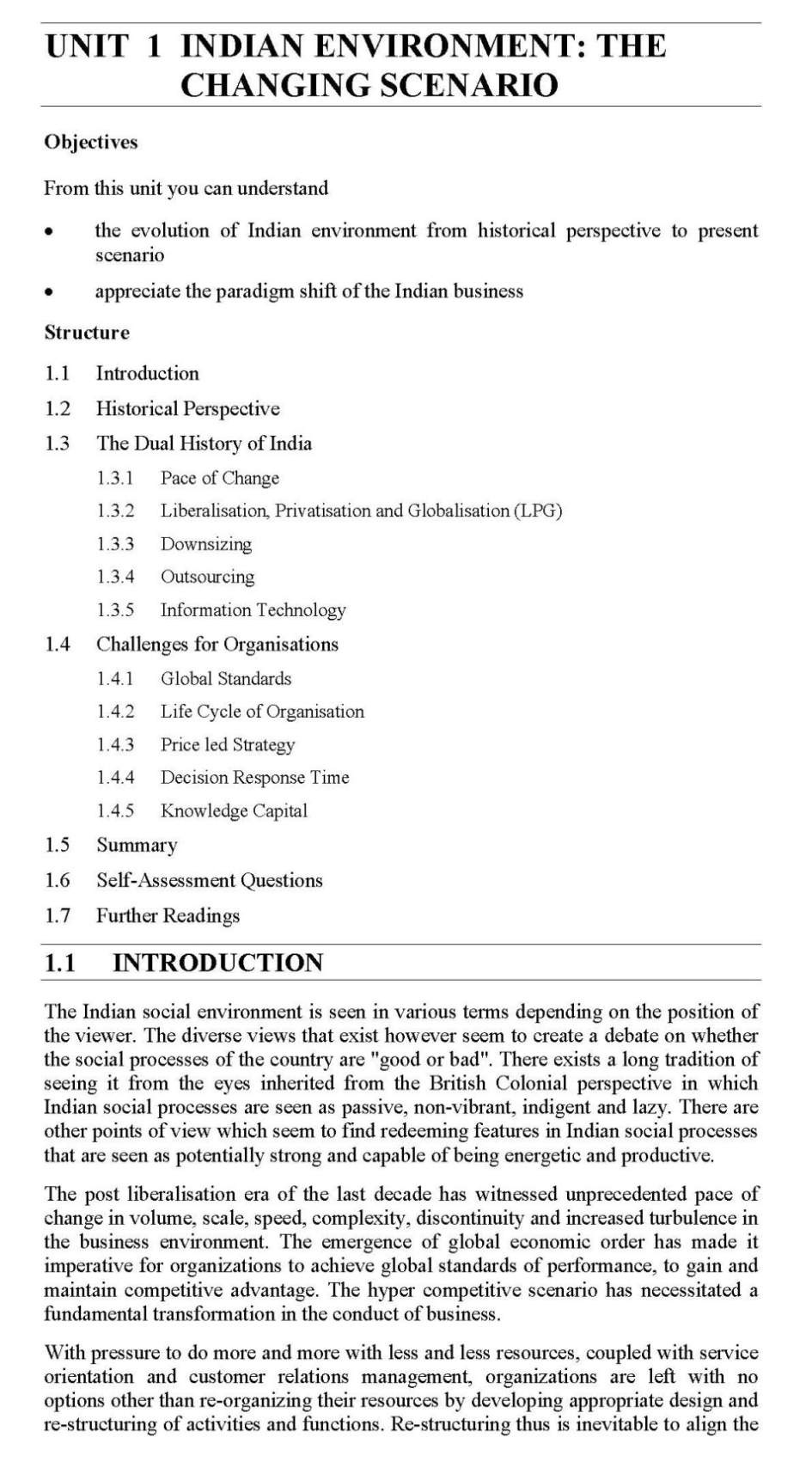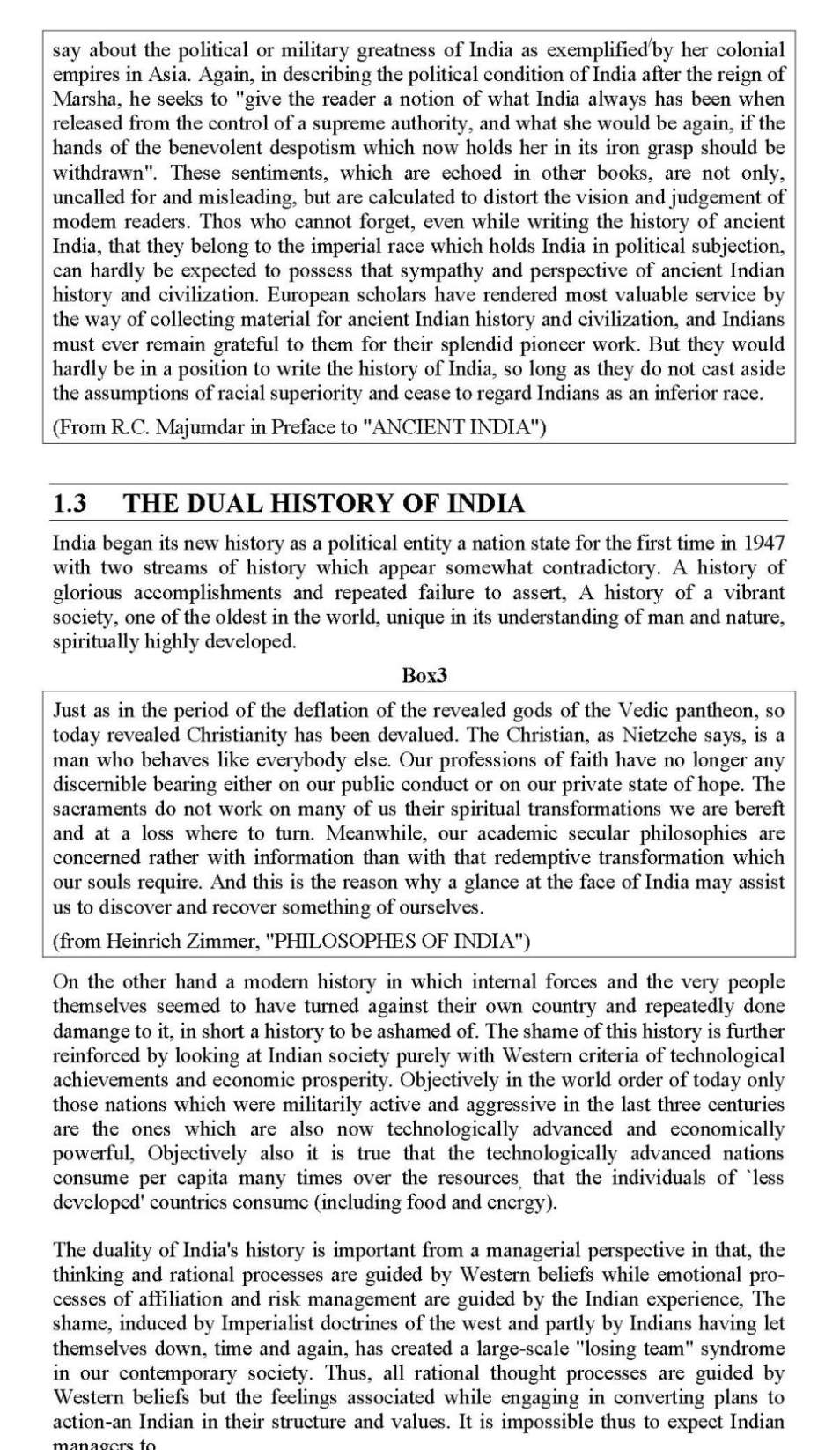|
#2
5th August 2015, 03:51 PM
| |||
| |||
| Re: IGNOU HRM notes
As you want to get the IGNOU Post Graduate Diploma in Human Resource Management notes of Social Processes and Behavioural Issues and Human Resource Development so here is the information of the same for you: INTRODUCTION: The Indian social environment is seen in various terms depending on the position of the viewer. The diverse views that exist however seem to create a debate on whether the social processes of the country are "good or bad". There exists a long tradition of seeing it from the eyes inherited from the British Colonial perspective in which Indian social processes are seen as passive, non-vibrant, indigent and lazy. There are other points of view which seem to find redeeming features in Indian social processes that are seen as potentially strong and capable of being energetic and productive. The post liberalisation era of the last decade has witnessed unprecedented pace of change in volume, scale, speed, complexity, discontinuity and increased turbulence in the business environment. The emergence of global economic order has made it imperative for organizations to achieve global standards of performance, to gain and maintain competitive advantage. The hyper competitive scenario has necessitated a fundamental transformation in the conduct of business. With pressure to do more and more with less and less resources, coupled with service orientation and customer relations management, organizations are left with no options other than re-organizing their resources by developing appropriate design and re-structuring of activities and functions. Re-structuring thus is inevitable to align the internal processes and systems to changes in the external environment. This will have a far reaching impact on behavioural processes in organizations. HISTORICAL PERSPECTIVE Objectively India has been, for ever, a region wherein diversity of beliefs, faiths and ideologies have poured in from all over the world. Thus today India is one of the largest combinations of faiths, languages and customs. No other nation in the world has so many current languages and customs as India has. No other country boasts of a larger number of faiths and ideologies without coercive forces demanding uniformity. To this objective fact there exists a diversity of responses. The lines of responses of all alien perspectives find this multiplicity and diversity an unmanageable and bewildering liability. In the nineteen forties the West had predicted a disintegration of India into smaller countries within 20 years of finding Independence from colonial rule. In this line of thinking the fact of India remaining one nation is a matter of mystery. The second line of response to the objective fact of multiplicity of our society is to search for an\underlying unity. The underlying unity lies in India being a culture state as opposed to the concept of nation state which has defined national boundaries (for instance) in Europe. In a nation state political ideology and processes of power distribution remains reasonably uniform giving rise to a national identity. Historically however India has been a culture state in which although many different political entities have flourished in the form of countries with a monarchy, the dominant elements of their culture have been uniform. This basic framework was demonstrated also in medieval Indian imperialism in which Indian culture was potent fountainhead and helped design societies in the far reaches of South East Asia. These countries were all politically independent but had institutionalised processes which had their origin in India. Thus, there was no central seat of power in India that determined governance of say Kampuchea but the Kampuchean people revelled in the Ramayana, Mahabharata and Budha's teachings. For their social organisation they held in value, ethics and living processes based on Indian philosophies. Following its own course of development, civilisation in India took a path in which militancy and military capabilities were neglected and allowed to wither away on a large scale. Intellectual and spiritual pursuits flourished however and are being continuously rediscovered by researchers. Indian society was deeply devoted to the generation of philosophical insights and treatises were written on them in great detail with a bewildering span of topics. In all this a core belief was that man is an expression of nature therefore aggression and violence were devalued, even in their universally accepted form of military prowess. This rendered the country vulnerable to foreign aggression. Earlier foreign aggressions were marked by a subsequent process of absorption and integration. The hallmark of the process of this absorption and integration were institutions which encouraged dialogue and recalibration of social, political, intellectual and religious norms for people to employ and follow. Box 1: The social design of the classical period in India postulated the institution of Rajasuya/ Dharma Yagna. The institutions could be activated through a call issued by a King to intellectuals of different persuasion of a region or the country to assemble for dialogues. A time and locale were set. The assembled intellectuals would be invited by the King to take stock of the social phenomenology, dysfunctionalities, deviances and deviations which had cropped up, dislocating the structural and interpersonal codings conventionally held as legitimate. In the allocated time the dialogue would crystallise recommendations which would legitimise some of the deviances and deviations. The assembly of intellectuals would also recommend structural modifications to create new space and identity for ethnic groups who had entered the area or had come into existence due to crossmarriages across the groups. The institution of Rajasuya/Dharma Yagna was a potent instrument in maintaining the process ambience of the society. Its constructive function was to recalibrate the correspondence, congruence, convergence and coherence of the human psyche of the era with the social design. The institution kept alive the resilience of the social design to cultural identity with a diverse ethos. The dialogue organized and integrated the experiential elements into new configurations of structural and interpersonal codes. It helped the individual to sustain his relatedness with the society instead of becoming an outsider. This hallmark institution provided Indian society the strength to review and recalibrate new inputs thus never creating the forces of majority versus minority, preventing the rise of fundamentalism and leaving society to continuously balance psychological needs and social organisation. But following the expansion of Islam the attacking forces chose to convert the populace rather than integrate with the existing culture. The newly entered crusaders for Islam became a ruling minority, they were then followed by the British, who too chose not to integrate but remain the ruling minority until 1947. The Muslim and the British brought with them a fresh look at the social organisation then prevailing in India. They brought an outlook more vigorous and egalitarian than which existed earlier. This provided a significant impetus to question some of the pathologies of the society such as untouchability, caste and rigid brahminical dogmas where institutional values had long ago disappeared. Until these new earnings from the Islamic and Christian beliefs could get integrated even freedom from foreign rule was difficult. Vivekananda, Deanna, Ramakrishna and finally Gandhi became the beacons who showed how this new learning could be integrated. As a society thus India has withstood for nearly a full century coercive state pressures to convert into religious which have had their beginnings in other cultures and cellmates - Near about 10th century the need to protect indigenous culture from state ' pressure to convert, turned the vibrancy of the earlier society dormant and created a society which reflected all signs of turning moribund, as if the social élan energy and vibrancy had been put in a kind of cold storage and all processes and institutions of re-vitalization renewal and change having been put under house-arrest. Later, Amber attempted a degree of integration by reactivating dialogue and religious eclecticism but with no success with his Deen-e-Illahi movement. The Sufis also tried integration through dialogic processes. Akbar's attempt failed completely and Aurangzeb put the Sufis behind bars. The decay and disintegration of Mughal power was an opportunity which was seized quickly ands efficiently by the British to assert their supremacy and governance. British governance drew its principles largely from the church and military ethics. These appeared to some degree non-partisan and "fair". The British however retained the firm belief that they were "civilizing" an "uncivilized" country. To this end Indian history was re-written by the colonisers to convey this point to the Indians who were learning English and to the rest of the world. IGNOU PGDHRM notes of Social Processes and Behavioural Issues and Human Resource Development     For more detailed information I am uploading 2 PDF files which are free to download: |